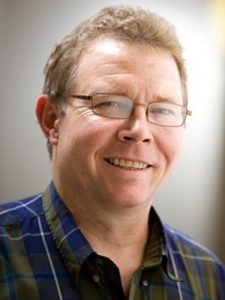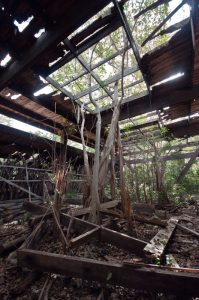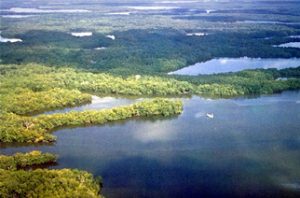Robert McClure
Executive Director and Co-Founder, InvestigateWest
B.S. Journalism 1982, Hall of Fame 2017
 After graduating from UF, the Florida native began a career arc that would take him from the swamps of Everglades National Park as a reporter for the South Florida Sun-Sentinel to Seattle as reporter for the Seattle Post-Intelligencer to founding his own non-profit investigative journalism website InvestigateWest.
After graduating from UF, the Florida native began a career arc that would take him from the swamps of Everglades National Park as a reporter for the South Florida Sun-Sentinel to Seattle as reporter for the Seattle Post-Intelligencer to founding his own non-profit investigative journalism website InvestigateWest.
Along the way, he was nominated for several Pulitzer Prizes and, in 1987, picked up a co-finalist honor in feature writing (with fellow CJC alum and Hall of Famer Michael Connelly).
He also was awarded two prestigious Knight journalism fellowships: the Knight-Wallace Fellowship at the University of Michigan where he studied sustainability and population dynamics/overpopulation and the Knight Science Journalism Fellowship at MIT where he studied climate. And, in 2002, he won the John B. Oakes Award for Distinguished Environmental Journalism.
What inspired you to devote so much of your career to natural Florida, and what keeps you at it decades later despite the ecological loss you’ve seen in that time?
I grew up in South Florida spending many a happy afternoon exploring the natural world, from a quick visit to the tiny fragment of what I’d later come to know as pine rocklands near my house, to epic backpacking and boating trips into the Everglades and the Big Cypress Swamp. I loved going outdoors.
By the time I came onto the environment beat in the late 1980s, I had seen vast swaths of southern Florida, including places where I used to camp with the Boy Scouts, paved over in favor of strip malls and overpasses. By then I’d also done a stint as the growth and development reporter in Palm Beach County when it was the fastest-growing county in the nation. So I brought a certain perspective to the beat, one necessarily informed by what I’d personally seen happen.
I threw myself into the Everglades story and spent the majority of my time covering that story for the next 10 years. I left Florida in 1999 for the Pacific Northwest, a region I had come to love.
I have to say that the unending spread of sprawl that I witnessed was probably a factor. (But then so were hurricanes, which I came to dread. One had me and photographer Sean Dougherty out on the Seven Mile Bridge in an SUV trying to sneak past cops to Key West as Hurricane Georges blew ashore. Not long before the next hurricane season commenced, I had accepted a job in Seattle.)
What’s your favorite story of how journalism or communication, your work or someone else’s, made a difference on behalf of Florida’s environment?
I have a hard time picking favorites of anything, so let me quickly relate a handful of examples.
- I grew up reading the work of Juanita Greene, The Miami Herald’s first environmental writer. Her coverage inspired (along with my journalism career) the establishment of Biscayne National Park, which had been targeted for an extensive development known as Islandia. Today it’s an incredibly precious oasis of water and gorgeous barrier islands amid concrete-crazed South Florida.
- About the same time, the Herald’s coverage (probably by Greene; I don’t recall) and editorials helped torpedo plans for a jetport in the middle of the Everglades that would have been five times the size of New York’s JFK.
- Long before he became known to American readers as the creator of characters such as a former governor who lives off roadkill and a guy with a weed whacker for a left hand, Carl Hiaasen was part of an incredibly effective Miami Herald reporting duo, along with Brian Duffy.
 They showed that a development on north Key Largo called Port Bougainville was being built illegally. It sought to plop down Mediterranean-style villas in on one of the rarest ecosystems anywhere, the subtropical hardwood hammocks of the northern Florida Keys. The development was stopped in its tracks. When I visited a few decades later to do a magazine story, the jungle was overtaking old half-constructed buildings, and in 2016 work began to remove the old buildings and roads. It’s now Dagny Johnson Key Largo Hammock Botanical State Park.
They showed that a development on north Key Largo called Port Bougainville was being built illegally. It sought to plop down Mediterranean-style villas in on one of the rarest ecosystems anywhere, the subtropical hardwood hammocks of the northern Florida Keys. The development was stopped in its tracks. When I visited a few decades later to do a magazine story, the jungle was overtaking old half-constructed buildings, and in 2016 work began to remove the old buildings and roads. It’s now Dagny Johnson Key Largo Hammock Botanical State Park. - The federal and state governments continue work in the Everglades on one of the largest ecosystem restoration projects on the planet. A lot of reporters covered that story for a long time. I, along with Miami Herald editorial writer Martha Musgrove, were the ones who stayed on it consistently from the time I came onto the beat in the late ‘80s until the U.S. Army Corps of Engineers announced its plans in the mid ‘90s. I remember getting a big scoop on that. We ran out the story on Thanksgiving Day, and it turned up on NPR that morning. I continued to dog the story for about five years longer. I felt a bit like a rat for leaving Florida and abandoning the Everglades. Fortunately The Washington Post soon had Michael Grunwald digging into the story with aplomb.
What’s the most critical environmental threat facing Florida, and the most meaningful action the state and its citizens can do to help?
Without a doubt, the most critical environmental challenge facing Florida is the same one facing our species in general: climate change. All that work done to restore the Everglades will be disrupted by the rising seawaters.
My lede on a 1997 climate change package in the South Florida Sun-Sentinel featured a man who liked to watch fish swim down his street a block off the beach in Hollywood when a northeaster and high tide coincided. Today it takes just an extremely high tide to send fish swimming through underground parking garages on Miami Beach. Moreso than many other states, Florida is threatened by rising seas. Climate change will be the news story of the century – or at least it should be – and nowhere is that more true than Florida.
What is your favorite spot in Florida to embrace its ecological wonders?
Wow, this is such a hard question to answer because there are so many possibilities: The wonderfully refreshing springs of North Florida. The white-sand beaches of the Panhandle. The clear waters and coral reefs of the Keys. The pine and palmetto flatlands of Central Florida. The mangrove forests of the 10,000 Islands. And of course the Everglades’ sawgrass prairies with interspersed tree islands and, very nearby, the cathedral-like jungles of the Big Cypress Swamp and the Fakahatchee Strand. The list could go on.
 But for me, at least, perhaps the most special place is Florida Bay, where I spent many a carefree hour as a youth fishing with my father and brothers, stopping off at Cape Sable for lunch and bringing back a bunch of fish for dinner. It was heaven.
But for me, at least, perhaps the most special place is Florida Bay, where I spent many a carefree hour as a youth fishing with my father and brothers, stopping off at Cape Sable for lunch and bringing back a bunch of fish for dinner. It was heaven.
When I was a young reporter in South Florida and started dating a young woman named Sally Deneen, I made sure to show her Florida Bay. Eventually, we decided to get married there. The ceremony was held on a tourist boat known as the Bald Eagle, which was escorted to our anchoring spot by a pair of dolphins. That was one of the happiest days of my life. Nine days later, Hurricane Andrew demolished the Bald Eagle and much of the bayside town of Flamingo. But Florida Bay remains an incomparable place of beauty and serenity.
What would you advise current CJC students about how/whether their work may help protect Florida’s wild lands, waters and creatures — and all of us?
I believe that we as journalists not only can make a difference in the world, but also that we are duty bound to make that our never-ending goal. Journalism is here to hold a mirror up to society, to show not only what we are doing wrong but also to offer potential solutions to the shortcomings we catalog and explore. If it were not for the efforts of journalists who came before me and after me, Florida would be much more economically bankrupt. So much would have been lost that is now our common treasure.
I am not recommending advocacy journalism but rather following the disciplines of traditional journalism: seeking out facts and data; diving into the science; asking questions that watchdog government, business, environmentalists and others involved in the fray. We are there as surrogates for the public, and we owe our fellow citizens a promise that we will do our utmost to safeguard the public interest.
